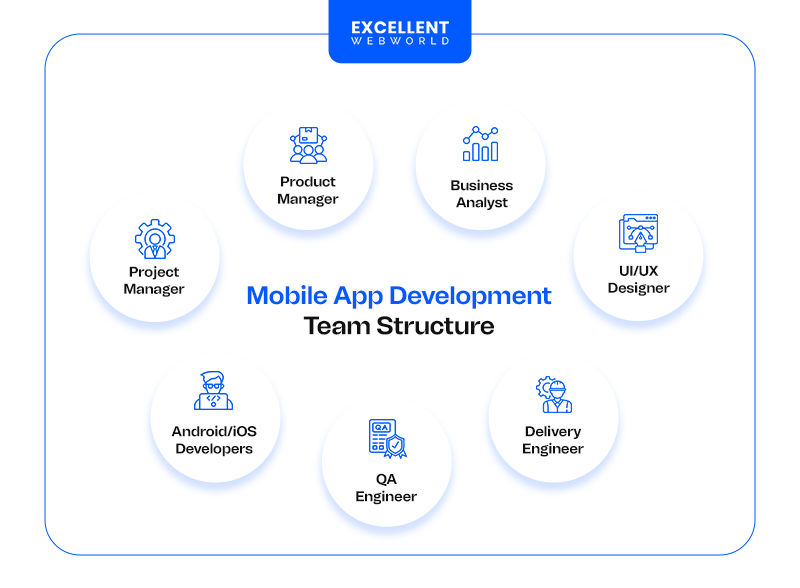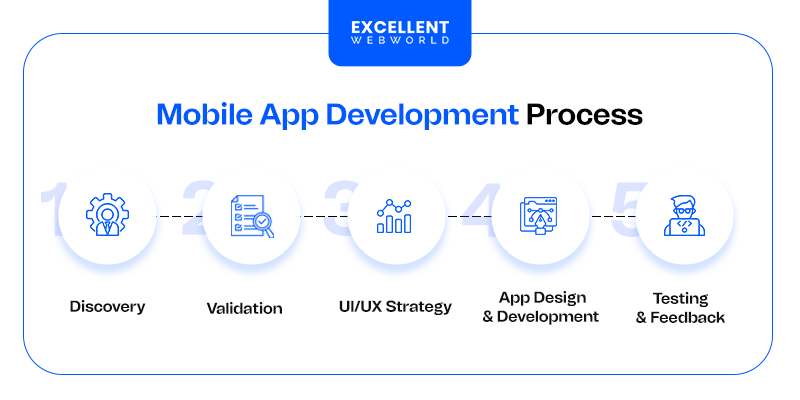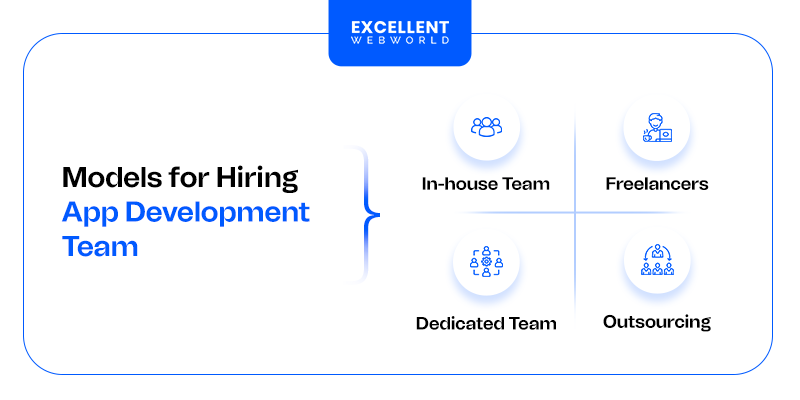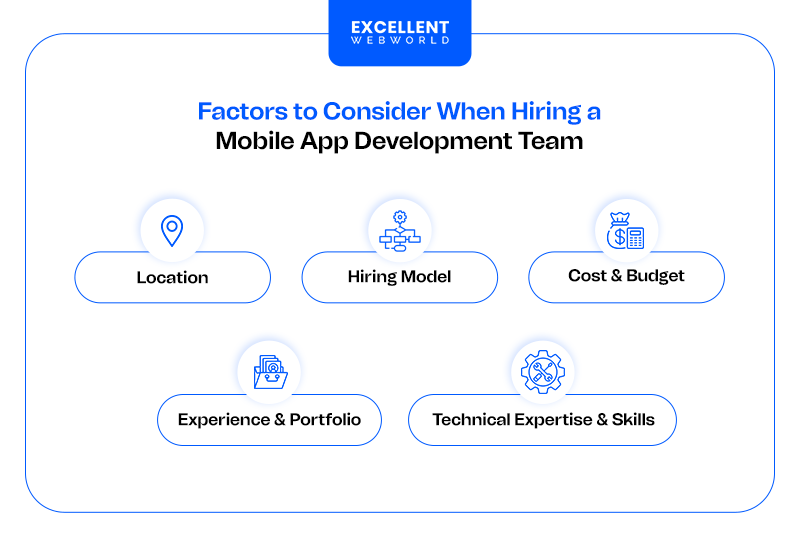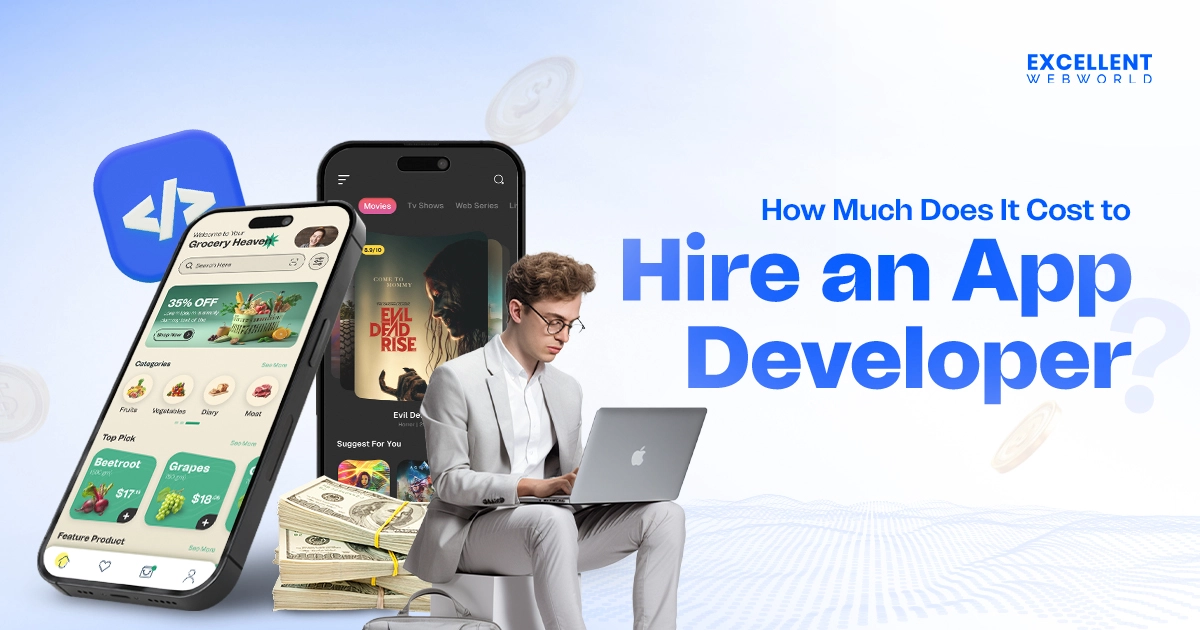With the expansion of reliance on modern technologies and smartphones, mobile app downloads worldwide are also increasing. Even recent research suggested that consumers are estimated to download 143 billion mobile applications from the Google Play Store and 38 billion from the Apple App Store in 2026. This is a clear sign of the potential of the mobile app development segment in the coming years.
However, the mobile app development team structure plays a key role in creating user-friendly apps based on specific requirements to stay ahead of the curve. An app-building team includes project managers, designers, developers, and QA personnel with experience in providing optimized and high-performing apps.
In this guide, we walk you through the requirements of an app development team structure, including their expertise, roles, and responsibilities. We will also cover the process of hiring an expert team and the app development cycle that must be followed.
Why Do You Need a Mobile App Development Team
To create a successful and market-leading software, it is important to build a robust app development team structure. There are several reasons for building a mobile app development team listed below:
Field Expertise
Hiring developers and designers without in-depth knowledge of advanced technologies is a critical risk. An outdated or poorly designed app can harm brand reputation, hinder user engagement, and lead to costly redevelopment efforts. To maintain a competitive advantage, enterprises must invest in highly skilled designers and developers with expertise in building custom and futuristic applications.
Proven Past Experience
Your app development team must have a track record of delivering successful, high-performing apps. Experience directly impacts app quality, security, and time to market. Without past experience, teams face delays, inefficiencies, and financial losses, but an experienced team helps accelerate deployment, reduce risk, and optimize development costs by ensuring a smooth development cycle.
Handle Complex and Scalability Needs
Scalability is a critical factor to consider when creating an app development structure. If your development team cannot handle complex system architecture and changing business needs, your application may experience performance issues, security vulnerabilities, and limited adaptability. Selecting a mobile app development team that can forecast scalability is essential to ensure long-term stability and business growth.
Strategic Cost and Time Allocation
Businesses can’t afford inefficiencies in cost and time management. A highly skilled development team ensures optimum resource utilization, focuses on core functionalities, and controls unnecessary costs. The cost of app development depends on the team’s experience and project complexity. So, it is important to streamline the development cycle, enhance innovation, and maximize ROI.
Understanding Basic Mobile App Development Team Structure
A mobile application development team involves experts such as a project manager, product owner, business analyst, designers, developers, QA, and delivery manager. Every team member is responsible for defined activities to build suitable applications based on the client’s requirements. Several IT augmentation service providers provide an experienced and dedicated team to create high-tech mobile applications for Android, iOS, or both.
1. Project Manager
When creating a mobile app development team structure, the project manager is the key person responsible for app development project management and correlation between team members, who monitor the project’s progress and timeline, resources involved, and specifications.
A project manager is an expert in different development approaches (Agile, Scrum, waterfall, etc.) and technologies (React, Swift, Flutter, etc.) to provide streamlined workflows and achieve set outcomes.
| Skill Requirement | Roles and Responsibilities |
|---|---|
|
|
|
2. Product Manager and Owner
A product owner is accountable for developing mobile applications that align with customer needs. They are responsible for determining new features and app optimization opportunities and ensuring the app adapts to changing business objectives and customer needs.
They help with smooth app development project management and provide top-notch value to apps that aim to boost performance and user experience.
| Skill Requirement | Roles and Responsibilities |
|---|---|
|
|
|
3. Business Analyst
Do you know business analysts are the face of the company? Wondering why? They are the bridge between app development service providers and clients. Business analysts collect and analyze project requirements and create detailed project documentation with technical requirements, timelines, and required functionalities.
Business analysts create a workflow and required processes of application to meet project goals and fulfill user expectations.
| Skill Requirement | Roles and Responsibilities |
|---|---|
|
|
|
4. UI/UX Designer
According to a recent analysis, 88% of users are less likely to return after a bad user experience. So, to boost engagement, it is essential to focus on user experience and easy-to-navigate interfaces. UI/UX designers are responsible for engaging users with intuitive designs. They focus on app design and usability by analyzing user requirements and market trends and creating wireframes and prototypes using essential design components.
Hire UI/UX designers to ensure that the app flow is streamlined and responsive across different devices. They commonly use Figma, Adobe XD, and Sketch to create custom designs for mobile apps.
| Skill Requirement | Roles and Responsibilities |
|---|---|
|
|
|
5. Android/iOS Developers
In the app building team, mobile app developers are the ones who give life to app design. They create and write clean coding structures from Android, iOS, or both. They use platform-specific technologies or cross-platform technologies if an app is to be used for both Android and iOS. Technologies include Objective C and Swift for iOS, Kotlin, Flutter, Xamerin, and others for cross-platform and Android app development. So, it is essential to specify the app development platform and experienced iOS and Android app development service providers to fulfill project requirements and build market-leading applications.
| Skill Requirement | Roles and Responsibilities |
|---|---|
|
iOS development team
Android development team |
|
6. QA Engineer
Quality Assurance Engineers use different testing types and create strategies. They test the app to discover bugs, performance faults, loading speed, responsiveness, and app flow. Developers solve the bugs found to ensure uninterrupted and smooth usability.
| Skill Requirement | Roles and Responsibilities |
|---|---|
|
|
|
7. Delivery Engineer
The delivery head monitors and ensures smooth project delivery to the client. With their technical and non-technical expertise in the field, they create app strategies and help achieve the set goals. With their guidance, the app development lifecycle can be optimized to streamline the process for user-centric solutions.
The delivery engineer helps establish a smooth app launch and deployment process.
| Skill Requirement | Roles and Responsibilities |
|---|---|
|
|
|
Roles and Responsibilities of App Development Team Based on Development Stages
Building an app depends on its coding structure and design. When creating app development teams, establishing the mobile application developer roles and responsibilities becomes core. The mobile app development process involves determining the required skills, timeline, budget, resources, and support throughout the development lifecycle
1. Discovery
To build a strong base for your mobile app development, start by clearly defining goals, key features, and unique selling points (USP). Conducting thorough research to identify your target audience, analyze market trends and various technology options to determine the most suitable tech stacks that best suit the project objectives. In this phase, you can also begin developing an initial prototype to visualize the core functionalities of the app.
| Team Member | Responsibilities |
|---|---|
| Project Manager | The project manager helps in determining the process, target market, and tech stacks |
| Product Manager | Product managers conduct in-depth analysis of target market segments to understand user expectations and create strategies to fulfill them |
| UI/UX Designer | UI/UX design team create initial prototypes |
2. Validation
Validate your app development idea to ensure it seamlessly aligns with project specifications and market needs. Gather user feedback on a prototype to analyze its adaptability to the intended audience. Use this input to refine project concepts before moving into the design phase.
| Team Member | Responsibilities |
|---|---|
| Project and Product Manager | Product and project managers validate the project specifications and market analysis done in the first stage |
| UI/UX designer | UI/UX team creates a basic MVP structure |
3. UI/UX Strategy
Create robust and user-centric design strategies by exploring UI/UX trends, tools, and best development practices. The main goal of performing this is to create visually appealing and engaging interfaces to boost user experience. You can also outsource mobile app design services to get access to expert insights and streamline the design process.
| Team Member | Responsibilities |
|---|---|
| Project Manager | Manage the overall app development plan and specify the design strategy |
| Product Manager | Provides strategic insights based on user feedback |
| UI/UX Designer | Create a design strategy and list the required tools. Create wireframes and essential mockups, including specific design components |
| Mobile app developer | Provide technical suggestions for designing to make interactive mobile app |
| Backend Developers | Evaluate the possibilities of created design with a backend setup |
4. App Design and Development
It’s the time to implement a design strategy to create UI/UX, ensuring smooth flow. Once finalized, submit the full proof design for approval and initiate the development process. In this phase, you create a coding structure and database and develop the frontend by integrating the required features to ensure optimal functionality.
| Team Member | Responsibilities |
|---|---|
| UI/UX Designer | Create and manage app design by implementing suitable mockups created previously. Ensuring smooth UI |
| Mobile App Developers | Develop an app for a specific operating system based on UI/UX created |
| Backend Developer | Build server-side architecture, database, and API integration into the app |
| Project Manager | Coordinate with the development team and ensure the team is following the deadlines |
| Product Manager | Manage smooth communication with different teams and ensure compliance is followed. |
5. Testing and Feedback
Before deploying the app, rigorous testing on usability, performance, responsiveness, and compatibility is done to identify potential issues and resolve them to enhance user experience. This phase also includes planning future updates to align with user needs and staying competitive.
| Team Member | Responsibilities |
|---|---|
| QA Engineers | Conduct comprehensive app testing to find bugs and create documentation |
| Mobile App Developers | Referring to documentation and fixing errors |
| Backend Developers | Determine the scope of improvement from the backend and optimize existing features or implement new ones(if required) |
| Project Manager | Research, listing, and helping in implementing different forms of testing |
| Product Manager | User feedback gathering and deciding future updates |
What are the Models for Hire Experienced App Development Team
Various models exist for building a solid iOS and Android app development team. Based on the project requirements, you can select the most suitable approach to hire dedicated app developers who help to lower costs and provide high-quality apps.
1. In-house Team
The in-house model involves hiring an in-house mobile app development team to create a custom solution. With an in-house team, businesses can fully control the resources and development cycle. This model also enables smooth team collaboration and boosts productivity by aligning them with company structure and values.
However, hiring an in-house team can be expensive compared to having a remote team. Building an in-house team can lead to additional costs, including hiring, onboarding, training, and other expenses. It is suitable for large development projects.
| Pros | Cons |
|---|---|
| Enhanced control over resources and smooth project management | Incur costs like salaries, infrastructure, benefits, and others |
| Smooth communication and collaboration between team members | The time-consuming process of recruitment |
| Better productivity and alignment with company values and goals | Limited flexibility to scale and adjust team size |
| Business growth and long-term investment in setting up an expert team | Risk of turnover |
2. Freelancers
The most cost-effective model for hiring app developers is hiring expert and experienced freelancers. This is because hiring freelancers can reduce the cost by up to 55% for companies as compared to other models. Additionally, it provides access to a large pool of resources from varied locations with a quick hiring process as compared to in-house hiring of resources.
On the other hand, managing people and ensuring high-quality output from them can be a challenge compared to on-site resources. However, when a company has a limited budget, hiring freelancers is the best option.
| Pros | Cons |
|---|---|
| Cost-effective (up to 55% cheaper than other models) | Requires proper management and real-time monitoring |
| Quick hiring process | Work quality may differ based on the skills of freelancers |
| Flexible hiring based on project needs | Communication gap (time zones, remote work schedule) |
| Enhanced access to talent pool from various locations | Lack of long-term commitment |
3. Dedicated Team
A dedicated team is a group of experts who are hired to perform their activities on a specific project for a defined time duration. They are often hired for long-term projects. A remote team of experts who do not belong to the client’s entity comprises a project manager, UI/UX designers, frontend and backend developers, QA experts, and implementation experts. The dedicated team is cost-effective and easy to manage.
However, managing this type of team can be complex due to the different time zones and the risk of data breaches and confidentiality.
| Pros | Cons |
|---|---|
| Cost-effective remote and offshore team setup | Requires strong project management |
| Access to specialized experts(designers, developers, and QA) | Time zone differences can lead to delays in communication |
| Enhanced Scalability based on project needs | Security risks with intellectual property and data protection |
| Teamwork dedicatedly to your project | Potential communication gaps due to remote setup |
4. Outsourcing
Outsourcing means allowing an expert third party to manage project processes on your behalf. The main advantage of this approach is that it provides access to a ready-made expert team with a streamlined workflow. So, it is an ideal choice for starting a new project that requires an experienced team.
However, this model can be challenging in establishing smooth communication channels between the team and lacks flexibility in project management.
| Pros | Cons |
|---|---|
| Access to an experienced, ready-made team | Communication barriers (language, time zones, unclear expectations) |
| Cost-effective, particularly with offshore outsourcing | Limited flexibility to make last-minute changes |
| Faster time to market with streamlined processes | Potential security risks with shared data and intellectual property |
| Expertise and efficiency from specialized vendors | Possible mismatch in quality standards if not closely managed |
| Product Manager | Manage smooth communication with different teams and ensure compliance is followed. |
What are the Factors to Consider when Hiring a Mobile App Development Team
Diverse factors should be considered when deciding on a mobile app development team to create fully functional and reliable solutions.
Location
The location of the app building team can greatly impact cost, team collaboration, and expertise. So, it is crucial to consider the location factor when creating a remote team.
Hiring Model
When hiring an experienced mobile app development team, it is essential to select the ideal hiring model, such as an in-house team, freelancers, outsourcing, or dedicated remote team. Based on the selected model, project specifications and milestones are set.
Cost and Budget
App development costs are based on various factors, including complexity, the amount of customization required, location, the payment cycle, and the pricing model. Different pricing models are available, including hourly, weekly, milestone-based, and fixed-price.
Experience and Portfolio
Before selecting the app development team, it is crucial to check the portfolio of past projects to ensure expertise in the industries and technology chosen. It is also essential to explore the experience and past work of individuals from different locations.
Technical Expertise and Skills
When selecting a mobile application development team, exploring technical knowledge and skills should be there to create functional, optimized, responsive, and high-performing apps. It is crucial to analyze their understanding of programming languages and backend technologies, as well as their knowledge of security standards and UI/UX design skills.
Conclusion
With this detailed guide, it is clear that a solid app development team structure is the core of a successful mobile app. Based on our analysis of key team members and their roles and responsibilities in app development, the process can be streamlined.
You can hire mobile app development service providers like Excellent Webworld to create feature-rich and optimized apps. Outsourcing to us helps you create industry-leading, custom mobile applications that boost business ROI.
Fulfill your app development requirements and create expert app development teams
by connecting with our team.
Frequently Asked Questions (FAQs)
Mobile app developers utilize programming languages and diverse tools to design, develop, test, and provide constant support for diverse mobile applications. They focus on platform-specific( Android or iOS) compatibility, UI/UX, and responsiveness.
To manage the mobile app development team, it is necessary to focus on establishing smooth communication, comprehensive project planning, defining team roles, using project management tools, examining the real-time progress, and determining and mitigating challenges. Additionally, it is essential to ensure that every team member understands their roles and responsibilities.
A solid mobile app development team structure involves a product and project manager, UI/UX designer, mobile app developers(iOS and Android), backend developer, and QA engineer. These team members are looking after specific roles and responsibilities based on project requirements and complexities. A team structure is created based on the budget and timeline, and the members work collaboratively with each other.
To hire an app development team, the following steps are followed:
You can hire expert app developers from different platforms, including Fiverr, Upwork, and others, who provide access to a large pool of resources.
But, if you are looking for reliable service providers and an expert mobile app development team, you can approach experienced organizations like Excellent Webworld, which has more than a decade of experience in the field and is dedicated to delivering top-notch mobile app development services.

Article By
Paresh Sagar is the CEO of Excellent Webworld. He firmly believes in using technology to solve challenges. His dedication and attention to detail make him an expert in helping startups in different industries digitalize their businesses globally.

